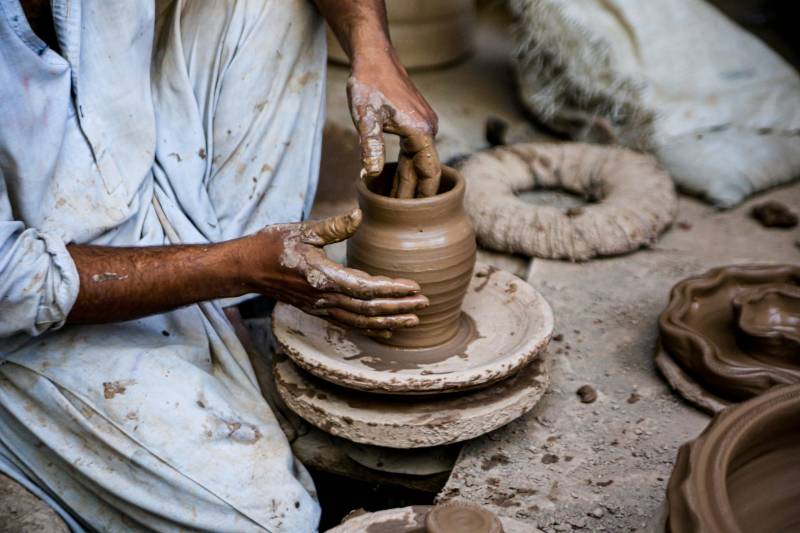
PESHAWAR: Having heard of the potter’s wheel many times, I was watching it rotating and a potter’s hands at work for the first time.
Only the wheel-head (turntable) was visible to me as it was above the floor surface while the stick used to rotate it was placed in a cavity under the ground.
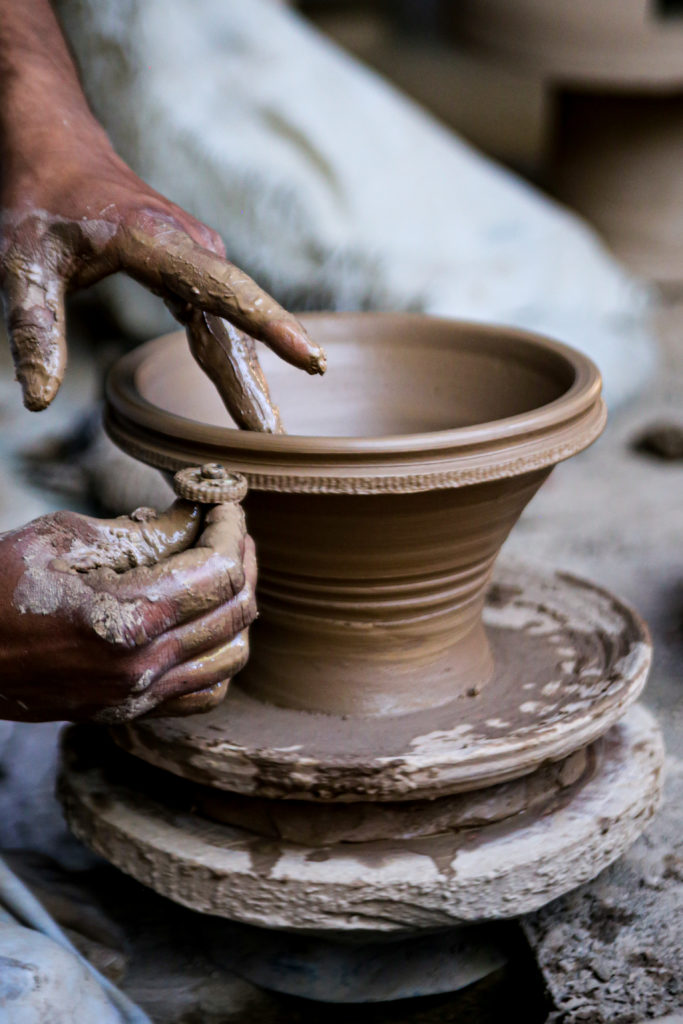 The young potter was rotating the turntable with the stick using foot power dangling his right leg under the ground while he himself was sitting on the floor.
The young potter was rotating the turntable with the stick using foot power dangling his right leg under the ground while he himself was sitting on the floor.
Placing a ball of clay in the centre of the wheel-head, he pressed, squeezed and pulled it gently upwards and outwards into a hollow shape. Shaping the walls to an even thickness, he trimmed the excess clay to refine the shape.
He carved a round-shaped platter with a bowl fixed to its centre. To his right side, there was a small cavity in the ground filled with water. After giving shape to the pot, he wetted a piece of cloth to give finishing touches to the pot rotating on the turntable. Using a tiny plastic gear attached to a needle, he made a beautiful pattern on the brims of the pot. Then he used a needle, lying next to him, to engrave an intricate pattern on the piece.
In urban households, this platter is placed it gardens to feed birds, but I came to know about its another usage for rural communities.
“In the bowl, you can place a food item and fill the outer brim with water so that no bug or insect can reach the eatables, explained Waheedullah, 21, who has been doing pottery for almost seven years. It has been their family profession since long.
Pottery is one of the oldest professions. It is the process of forming vessels and other objects with clay and other ceramic materials, which are fired at high temperatures to give them a hard, durable form.
 Waheedullah is one of the potters inhabiting Haji Abad area of Surrezai Payan on the suburbs of the Peshawar city that is also known as Kulalano Kalay (potters’ village) in Pashto language as most of the families living in the village have been into pottery. Phandu Road serves as a short cut to the locality that can also be reached from Chamkani area. Reaching Phandu Chowk, you have to take the Inqilab Road that leads straight to the village situated on the right side of the road.
Waheedullah is one of the potters inhabiting Haji Abad area of Surrezai Payan on the suburbs of the Peshawar city that is also known as Kulalano Kalay (potters’ village) in Pashto language as most of the families living in the village have been into pottery. Phandu Road serves as a short cut to the locality that can also be reached from Chamkani area. Reaching Phandu Chowk, you have to take the Inqilab Road that leads straight to the village situated on the right side of the road.
While Waheedullah was busy demonstrating the pot-making process to me, his uncle Nisar Khan was explaining little details.
“We are from Khalil Mohmand tribe of Pashtoon. Pottery is the profession of our forefathers. We learn it and then pass it on to our children”, said the 45-year-old man who shares a vast mud-house with his elder brother Mohammad Yousaf. They also have their pottery production setup in the same place.
As people in villages marry off at a young age, the families of the married sons of both the brothers also live in the same house in a joint family setup.
In front of the rooms where the extended family lives, they have also erected a shade where their two cows and a calf were grazing. The courtyard, where there is a pottery setup, also serves as a stocking place for the finished products that include planters of varying sizes and shapes, birdhouses, kitchen utensils and water dispensers.
Explaining things out to me, Nisar said that the clay they use to make pots is brought from Sheikh Mohammadi village and Sarband area as it was one of its kind only used in pottery. “This is different from the clay used for making bricks,” he elaborated.
A potter makes almost 40 items a day. After making a pot, they place it in the sun for 15 to 20 minutes. Then it dries in shade for almost six to seven days before being fired in a kiln for nearly four hours. After that, they leave it there in the kiln for at least one day before it is taken out to be sold to shopkeepers.
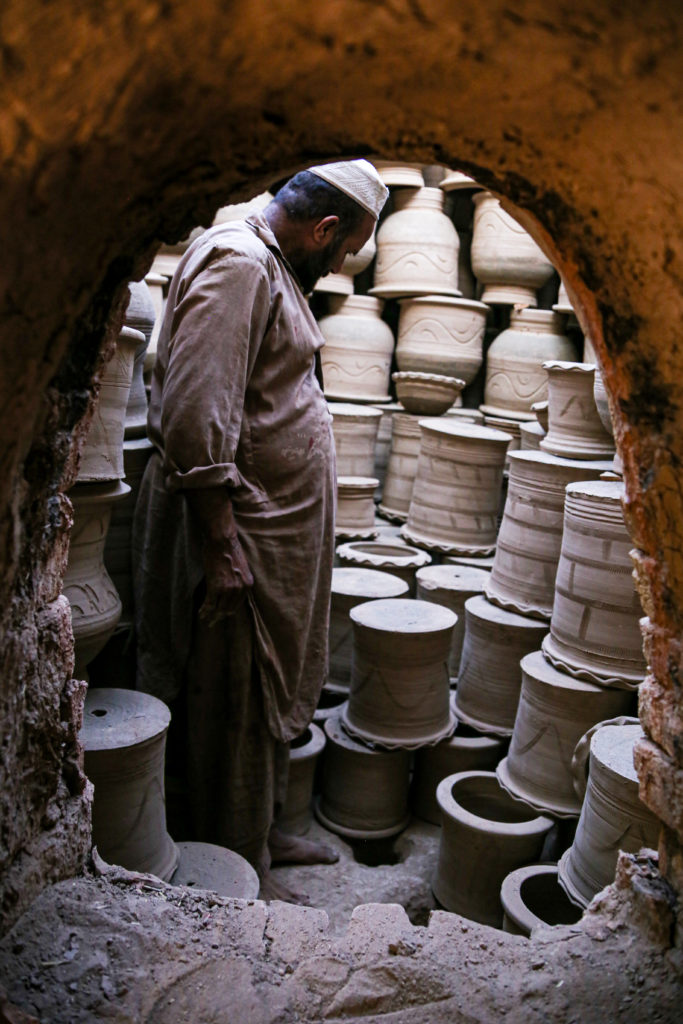 The kiln is a round mud structure without a roof and with an entrance dot. The defected pots are used to cover the roof during firing process. Under the floor, there is a pit to place fuel for lighting a big fire that has a separate opening. The kiln floor has vents in it where pots are stacked for baking.
The kiln is a round mud structure without a roof and with an entrance dot. The defected pots are used to cover the roof during firing process. Under the floor, there is a pit to place fuel for lighting a big fire that has a separate opening. The kiln floor has vents in it where pots are stacked for baking.
Showing me the firing pit, Nisar said that the flames sometimes start to leap out of it. So you ought to be careful.
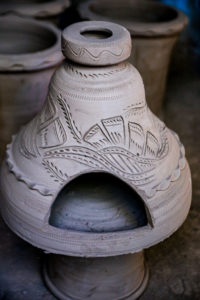 Two kilns were constructed on the house premises. One next to the building’s main entrance and the other just in front of the family rooms where a toddler was taking a nap with a tiny battery-run fan fixed on his cradle. While listening to Nisar Khan, on the back of my mind I was thinking how hot it would be for the house dwellers during summers when the hot weather reaches its peak and the heat of two kilns also adds to the rising temperatures.
Two kilns were constructed on the house premises. One next to the building’s main entrance and the other just in front of the family rooms where a toddler was taking a nap with a tiny battery-run fan fixed on his cradle. While listening to Nisar Khan, on the back of my mind I was thinking how hot it would be for the house dwellers during summers when the hot weather reaches its peak and the heat of two kilns also adds to the rising temperatures.
He said we keep stocking our raw pottery for seven days and then heat our kiln once in a week to fire it as baking part of pottery making is expensive due to the cost of woodchips we use as a fuel.
“The retailers are at the gaining end as the buyers don’t have direct access to us. They get the largest planter from us at Rs 140 and sell it for Rs 500 in the city markets,” he said, adding that the Covid-19 pandemic had badly affected their business.
Because unglazed earthenware was porous, it had limited utility. The development of ceramic glaze made impermeable pottery possible while the addition of decoration has also evolved throughout its history.
Painting is often applied to pottery. The vessels may be decorated by shallow carving of the clay body whereas banding or lining is another form of decoration. It is the application of a band of colour to the edge of a vessel on a potter’s wheel.
Every potter in the village has his own expertise and is making different pieces of pottery. Some have their own units while others who cannot afford to have their independent setups, work in factories as daily wagers. “If a worker makes an item worth Rs 100, the factory owner pays him Rs 40 only, Nisar went on to say adding that the wages of a worker depend on the number of items he makes in a day.
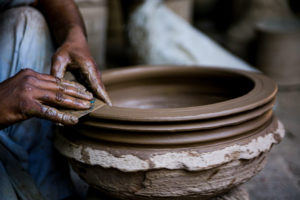 Although the village has natural gas and electricity facility, there is no government hospital. There are government schools for both boys and girls but none of the members of Nisar’s family is educated. Yet, they are hardworking, hospitable and humble.
Although the village has natural gas and electricity facility, there is no government hospital. There are government schools for both boys and girls but none of the members of Nisar’s family is educated. Yet, they are hardworking, hospitable and humble.
The art of pottery has developed a lot all over the world with the invention of modern techniques and technology. But this development has nothing to do with the work environment here in the potters’ village. They lead a simple life and do their best in their available resources. We look at their art as a profession or business rather than to appreciate it as an art. Although they are content with what they get and do not have any grievances.
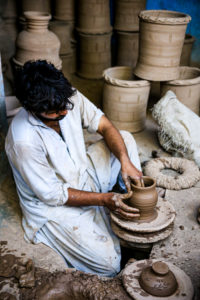 The family bid me farewell presenting some pottery items to me as a gift. This reminded me of my childhood. My father used to buy me clay toys and money box from the make-shift stalls set up by potters on the roadside near our ancestral graveyard situated in Ganj area as a large number of people visited graveyards to offer fateha at the graves of their loved ones on Yaum-e-Ashur, Shab-e-Baraat and Eids. These stalls near graveyards on such events are still a tradition. But now these temporary settlements have added much variety to the items they offer to their buyers.
The family bid me farewell presenting some pottery items to me as a gift. This reminded me of my childhood. My father used to buy me clay toys and money box from the make-shift stalls set up by potters on the roadside near our ancestral graveyard situated in Ganj area as a large number of people visited graveyards to offer fateha at the graves of their loved ones on Yaum-e-Ashur, Shab-e-Baraat and Eids. These stalls near graveyards on such events are still a tradition. But now these temporary settlements have added much variety to the items they offer to their buyers.
Showing me a glazed plate painted with intricate floral patterns, Nisar said that they got it from Lala Musa area of the Punjab province as it was their speciality. “Sister! Keep them soaked overnight to add to their durability,” he advised me.
One of my teachers used to say that working with soil is something that makes a person humble. I found this saying to be true while visiting the potter family.
Only the wheel-head (turntable) was visible to me as it was above the floor surface while the stick used to rotate it was placed in a cavity under the ground.
 The young potter was rotating the turntable with the stick using foot power dangling his right leg under the ground while he himself was sitting on the floor.
The young potter was rotating the turntable with the stick using foot power dangling his right leg under the ground while he himself was sitting on the floor.Placing a ball of clay in the centre of the wheel-head, he pressed, squeezed and pulled it gently upwards and outwards into a hollow shape. Shaping the walls to an even thickness, he trimmed the excess clay to refine the shape.
He carved a round-shaped platter with a bowl fixed to its centre. To his right side, there was a small cavity in the ground filled with water. After giving shape to the pot, he wetted a piece of cloth to give finishing touches to the pot rotating on the turntable. Using a tiny plastic gear attached to a needle, he made a beautiful pattern on the brims of the pot. Then he used a needle, lying next to him, to engrave an intricate pattern on the piece.
In urban households, this platter is placed it gardens to feed birds, but I came to know about its another usage for rural communities.
“In the bowl, you can place a food item and fill the outer brim with water so that no bug or insect can reach the eatables, explained Waheedullah, 21, who has been doing pottery for almost seven years. It has been their family profession since long.
Pottery is one of the oldest professions. It is the process of forming vessels and other objects with clay and other ceramic materials, which are fired at high temperatures to give them a hard, durable form.
 Waheedullah is one of the potters inhabiting Haji Abad area of Surrezai Payan on the suburbs of the Peshawar city that is also known as Kulalano Kalay (potters’ village) in Pashto language as most of the families living in the village have been into pottery. Phandu Road serves as a short cut to the locality that can also be reached from Chamkani area. Reaching Phandu Chowk, you have to take the Inqilab Road that leads straight to the village situated on the right side of the road.
Waheedullah is one of the potters inhabiting Haji Abad area of Surrezai Payan on the suburbs of the Peshawar city that is also known as Kulalano Kalay (potters’ village) in Pashto language as most of the families living in the village have been into pottery. Phandu Road serves as a short cut to the locality that can also be reached from Chamkani area. Reaching Phandu Chowk, you have to take the Inqilab Road that leads straight to the village situated on the right side of the road.While Waheedullah was busy demonstrating the pot-making process to me, his uncle Nisar Khan was explaining little details.
“We are from Khalil Mohmand tribe of Pashtoon. Pottery is the profession of our forefathers. We learn it and then pass it on to our children”, said the 45-year-old man who shares a vast mud-house with his elder brother Mohammad Yousaf. They also have their pottery production setup in the same place.
As people in villages marry off at a young age, the families of the married sons of both the brothers also live in the same house in a joint family setup.
In front of the rooms where the extended family lives, they have also erected a shade where their two cows and a calf were grazing. The courtyard, where there is a pottery setup, also serves as a stocking place for the finished products that include planters of varying sizes and shapes, birdhouses, kitchen utensils and water dispensers.
Explaining things out to me, Nisar said that the clay they use to make pots is brought from Sheikh Mohammadi village and Sarband area as it was one of its kind only used in pottery. “This is different from the clay used for making bricks,” he elaborated.
A potter makes almost 40 items a day. After making a pot, they place it in the sun for 15 to 20 minutes. Then it dries in shade for almost six to seven days before being fired in a kiln for nearly four hours. After that, they leave it there in the kiln for at least one day before it is taken out to be sold to shopkeepers.
 The kiln is a round mud structure without a roof and with an entrance dot. The defected pots are used to cover the roof during firing process. Under the floor, there is a pit to place fuel for lighting a big fire that has a separate opening. The kiln floor has vents in it where pots are stacked for baking.
The kiln is a round mud structure without a roof and with an entrance dot. The defected pots are used to cover the roof during firing process. Under the floor, there is a pit to place fuel for lighting a big fire that has a separate opening. The kiln floor has vents in it where pots are stacked for baking.Showing me the firing pit, Nisar said that the flames sometimes start to leap out of it. So you ought to be careful.
 Two kilns were constructed on the house premises. One next to the building’s main entrance and the other just in front of the family rooms where a toddler was taking a nap with a tiny battery-run fan fixed on his cradle. While listening to Nisar Khan, on the back of my mind I was thinking how hot it would be for the house dwellers during summers when the hot weather reaches its peak and the heat of two kilns also adds to the rising temperatures.
Two kilns were constructed on the house premises. One next to the building’s main entrance and the other just in front of the family rooms where a toddler was taking a nap with a tiny battery-run fan fixed on his cradle. While listening to Nisar Khan, on the back of my mind I was thinking how hot it would be for the house dwellers during summers when the hot weather reaches its peak and the heat of two kilns also adds to the rising temperatures.He said we keep stocking our raw pottery for seven days and then heat our kiln once in a week to fire it as baking part of pottery making is expensive due to the cost of woodchips we use as a fuel.
“The retailers are at the gaining end as the buyers don’t have direct access to us. They get the largest planter from us at Rs 140 and sell it for Rs 500 in the city markets,” he said, adding that the Covid-19 pandemic had badly affected their business.
Because unglazed earthenware was porous, it had limited utility. The development of ceramic glaze made impermeable pottery possible while the addition of decoration has also evolved throughout its history.
Painting is often applied to pottery. The vessels may be decorated by shallow carving of the clay body whereas banding or lining is another form of decoration. It is the application of a band of colour to the edge of a vessel on a potter’s wheel.
Every potter in the village has his own expertise and is making different pieces of pottery. Some have their own units while others who cannot afford to have their independent setups, work in factories as daily wagers. “If a worker makes an item worth Rs 100, the factory owner pays him Rs 40 only, Nisar went on to say adding that the wages of a worker depend on the number of items he makes in a day.
 Although the village has natural gas and electricity facility, there is no government hospital. There are government schools for both boys and girls but none of the members of Nisar’s family is educated. Yet, they are hardworking, hospitable and humble.
Although the village has natural gas and electricity facility, there is no government hospital. There are government schools for both boys and girls but none of the members of Nisar’s family is educated. Yet, they are hardworking, hospitable and humble.The art of pottery has developed a lot all over the world with the invention of modern techniques and technology. But this development has nothing to do with the work environment here in the potters’ village. They lead a simple life and do their best in their available resources. We look at their art as a profession or business rather than to appreciate it as an art. Although they are content with what they get and do not have any grievances.
 The family bid me farewell presenting some pottery items to me as a gift. This reminded me of my childhood. My father used to buy me clay toys and money box from the make-shift stalls set up by potters on the roadside near our ancestral graveyard situated in Ganj area as a large number of people visited graveyards to offer fateha at the graves of their loved ones on Yaum-e-Ashur, Shab-e-Baraat and Eids. These stalls near graveyards on such events are still a tradition. But now these temporary settlements have added much variety to the items they offer to their buyers.
The family bid me farewell presenting some pottery items to me as a gift. This reminded me of my childhood. My father used to buy me clay toys and money box from the make-shift stalls set up by potters on the roadside near our ancestral graveyard situated in Ganj area as a large number of people visited graveyards to offer fateha at the graves of their loved ones on Yaum-e-Ashur, Shab-e-Baraat and Eids. These stalls near graveyards on such events are still a tradition. But now these temporary settlements have added much variety to the items they offer to their buyers.Showing me a glazed plate painted with intricate floral patterns, Nisar said that they got it from Lala Musa area of the Punjab province as it was their speciality. “Sister! Keep them soaked overnight to add to their durability,” he advised me.
One of my teachers used to say that working with soil is something that makes a person humble. I found this saying to be true while visiting the potter family.
